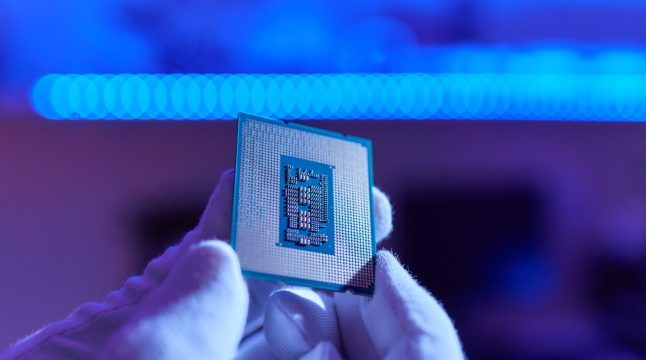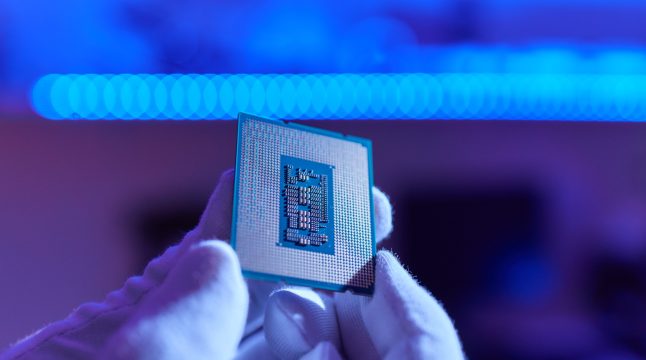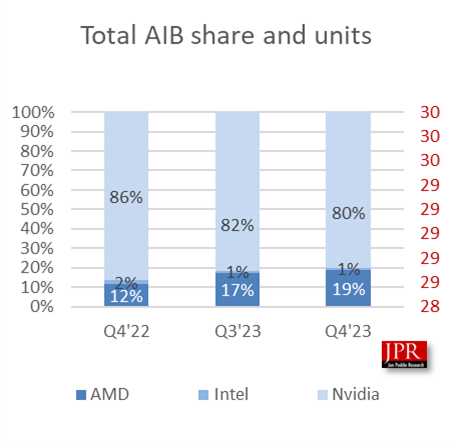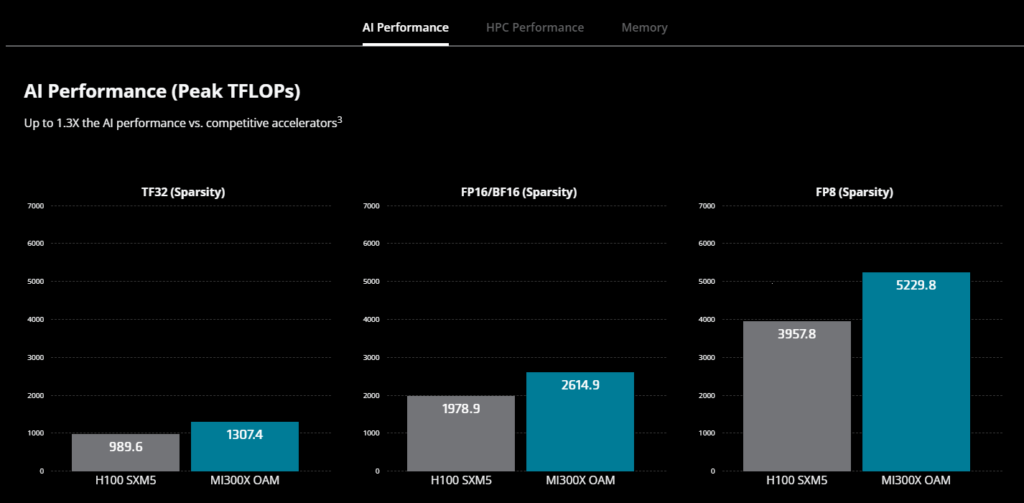
 Image courtesy of 123rf.com
Image courtesy of 123rf.com
Within a single year, Nvidia (Nasdaq: NVDA) gained a 260% valuation boost, increasing its market cap by $1.6 trillion. That is more than double the combined market cap of Nvidia’s three closest competitors: AMD, Intel, and Qualcomm.By outgrowing its video gaming roots into a data center supplier, Nvidia deftly scooped the hype spilling from the AI bandwagon train. Investors were further fortified in their confidence in February when Nvidia reported 765% year-over-year growth in earnings to a $22.1 billion revenue.However, the infrastructure for wide AI applications is just in the starting phase. On the long road, could Nvidia pop off amid stiff competition? Case in point, Cisco Systems (NASDAQ: CSCO) was once regarded as the most valuable stock in the world, only for its bubble to burst after its $555.4 billion market cap peak.These AI chip stocks have what it takes to tackle Nvidia’s current dominance.
Intel Corporation (Nasdaq: INTC)
Sharing CPU duopoly with AMD for the PC market, Intel is down 12% year-to-date. During 2023, Intel laid off 311 workers, with an additional 140 layoffs this year. Once the industry standards were set, Intel was perceived as having passed its glory.However, an established company like Intel has deep human capital and funds to turn its fortunes around. Intel still holds market share dominance in the integrated PC graphics market, at 68%, compared to AMD at 13% and Nvidia at 19%. Likewise, Intel CPUs make up 75% of the laptop market share.Moreover, Intel started to disrupt the AMD/Nvidia duopoly within the discrete GPU market segment in 2022. Settling for the mid-range segment, Intel’s ARC A750 and Arc A770 GPUs gained a 1% market share by Q4 2023.  Image credit: Jon Peddie Research (JPR)According to the latest report from Jon Peddie Research (JPR), add-in board (AIB) market shipments for discrete GPUs have increased by 32% Year over Year. From 2023 to 2028, Research and Markets forecasts a CAGR of 29.72% for the AIB market. To become more agile, Intel reorganized its divisions into Client Computing Group (CCG) and Data Center and AI (DCAI) as the main breadwinners.According to the latest earnings report, they both generated less revenue on an annual basis at $29.3 billion (CCG, down 8%) and $15.5 billion (DCAI, down 20%). Yet, the company continues deploying cutting-edge chips, such as the 5th Gen Intel Xeon, optimized for AI workloads. In January, Intel revealed its intention to tackle the auto AI chip market by acquiring French startup Silicon Mobility.To stand out from Qualcomm and Nvidia, Intel will align its supply of auto chips from low-tier to premium vehicles as a way to better scale. In collaboration with Qualcomm and Google to tackle Nvidia’s dominance within the UXL Foundation, Intel is deploying its open-source software tools, such as OneAPI.Due to these AI expansions and market entrenchment in key segments, Intel will likely see a turnover in 2025. In the meantime, 36 analysts aggregated by Nasdaq view the average INTC price target at $47.05 vs the current $41.90, with the high estimate going up to $68 twelve months ahead.
Image credit: Jon Peddie Research (JPR)According to the latest report from Jon Peddie Research (JPR), add-in board (AIB) market shipments for discrete GPUs have increased by 32% Year over Year. From 2023 to 2028, Research and Markets forecasts a CAGR of 29.72% for the AIB market. To become more agile, Intel reorganized its divisions into Client Computing Group (CCG) and Data Center and AI (DCAI) as the main breadwinners.According to the latest earnings report, they both generated less revenue on an annual basis at $29.3 billion (CCG, down 8%) and $15.5 billion (DCAI, down 20%). Yet, the company continues deploying cutting-edge chips, such as the 5th Gen Intel Xeon, optimized for AI workloads. In January, Intel revealed its intention to tackle the auto AI chip market by acquiring French startup Silicon Mobility.To stand out from Qualcomm and Nvidia, Intel will align its supply of auto chips from low-tier to premium vehicles as a way to better scale. In collaboration with Qualcomm and Google to tackle Nvidia’s dominance within the UXL Foundation, Intel is deploying its open-source software tools, such as OneAPI.Due to these AI expansions and market entrenchment in key segments, Intel will likely see a turnover in 2025. In the meantime, 36 analysts aggregated by Nasdaq view the average INTC price target at $47.05 vs the current $41.90, with the high estimate going up to $68 twelve months ahead.
Advanced Micro Devices (Nasdaq: AMD)
A constant companion of Nvidia and Intel in the segments above, AMD has made the heaviest inroads to tackle Nvidia. AMD introduced Instinct MI300X AI chips outside competitive discrete GPUs, offering a superior price-performance ratio to Nvidia’s H100s.  Image credit: AMDTensorWave, a cloud provider for training AI models, fully onboarded AMD’s offering, which suggests that other AI startups and companies are making similar price-performance calculations. If this trend continues, it could spell a repeat of the AMD-Nvidia discrete GPU wars. According to JPR, Nvidia still dominates this segment at 80% market share, but AMD’s GPU shipments increased by 117% during 2023. This increased AMD’s market share from 12% in Q4 2022 to 19% in Q4 2023. Being a smaller, more agile company than Intel, these results translated to the company’s positive growth figures.In the Q4 2023 report, Intel reported a 3,076% YoY increase in net income to $667 million. Even more tellingly, AMD increased its operating margin from negative 3% to positive 6% over the same period. Owing to its highly competitive CPU pricing, AMD also reached a new milestone in February by increasing its PC market share to 20.2% vs Intel’s 79.8%.Based on 36 analyst inputs aggregated by Nasdaq, the average AMD price target twelve months ahead is $201.26 vs the current $180, while the high estimate is $270 per share. Overall, this evens out INTC vs AMD’s potential average gains at 12%.More By This Author:GameStop Stock Gains Ahead Of Landmark Q4 Earnings Release
Image credit: AMDTensorWave, a cloud provider for training AI models, fully onboarded AMD’s offering, which suggests that other AI startups and companies are making similar price-performance calculations. If this trend continues, it could spell a repeat of the AMD-Nvidia discrete GPU wars. According to JPR, Nvidia still dominates this segment at 80% market share, but AMD’s GPU shipments increased by 117% during 2023. This increased AMD’s market share from 12% in Q4 2022 to 19% in Q4 2023. Being a smaller, more agile company than Intel, these results translated to the company’s positive growth figures.In the Q4 2023 report, Intel reported a 3,076% YoY increase in net income to $667 million. Even more tellingly, AMD increased its operating margin from negative 3% to positive 6% over the same period. Owing to its highly competitive CPU pricing, AMD also reached a new milestone in February by increasing its PC market share to 20.2% vs Intel’s 79.8%.Based on 36 analyst inputs aggregated by Nasdaq, the average AMD price target twelve months ahead is $201.26 vs the current $180, while the high estimate is $270 per share. Overall, this evens out INTC vs AMD’s potential average gains at 12%.More By This Author:GameStop Stock Gains Ahead Of Landmark Q4 Earnings Release
Three Heavy Industry Stocks To Buy As U.S. Gov. Prepares $6.3 Billion In Grants
Cathie Wood’s ARK Invest Reshuffles Portfolio: Trims Coinbase, Buys Reddit














